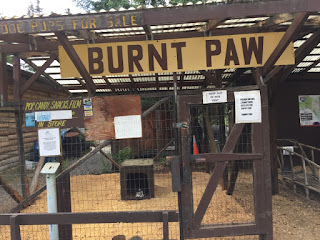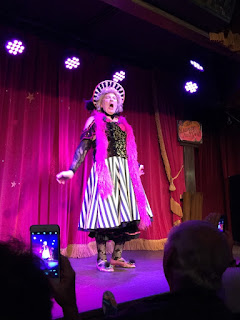 |
| John's in Yukon Territory, Canada and I'm in Alaska, USA |
 |
| Beautiful traditional beading demonstration at the Visitor Center |
That afternoon after setting up for our one night stay, we visited Burnt Paw Gift Shop and heard from a musher who ran in the first Iditarod race. We learned how they breed and train dogs. No puppies were out for us to hold.
Then we visited Jack Wade Gold Company and heard from the mine's owner about gold mining in the Yukon. The gold nuggets were passed around so we could hold them.
The next day we travelled to Fairbanks, Alaska. We were there for 5 nights. Along the way we stopped and bought some reindeer sausage.
In Delta Junction we stopped to pick up our certificate for reaching the end of the Alaska Highway.
We stopped at Rika's Roadhouse in Big Delta State Historical Park for a self-guided walking tour of the property and lunch in their café. In 1913 the roadhouse was a local center of activity for gold prospectors, local hunters, traders, and freighters.
 |
| Furnished with period pieces |
 |
| Close up view of log cabin construction |
 |
| Time for fun... |
On the way to Fairbanks a view of beautiful snowcapped mountains in the distance. They are Mt. Hayes, Hess Mt., and Mt. Deborah...
One interesting thing about traveling in Alaska is how long the days are. When we were in Fairbanks sunrise was at 3:19 am and sunset was at 12:29 am! We went to bed with sunlight and woke up with sunlight!
Our first full day in Fairbanks was July 4 and John and I signed up for an optional activity--a 9-hour tour Barrow, Alaska. Barrow is the northernmost city in the Unites States and is located north of the Arctic Circle. It has a population of 5,000, 70% of whom are Alaskan Natives. We were fortunate to be there during their 4th of July parade. There's nothing better than small town America on the 4th of July!
The streets are left unpaved due to the prevalence of permafrost. Permafrost is soil that is frozen for more than two consecutive years. On top of the frozen soil is a layer of soil that freezes and thaws every year. One interesting thing we noticed is that there are no plants, trees or grass in Barrow due to the harsh climate.
Because transporting food to the city is very expensive, many residents continue to rely upon subsistence food sources. Whale, seal, polar bar, walrus, waterfowl, caribou, and fish are harvested from the coast or nearby rivers and lakes. In the local grocery store, we saw a head of iceberg lettuce for $5.99 and a head of cauliflower for $7.99!
It was a good 30 degrees colder than Fairbanks--35, cloudy, windy, with a constant 30 mph wind.
 |
| We touched the Arctic Ocean! |
 |
| Bowhead whale skull |
How did we get to Barrow? On a 6-hour round trip flight in a small, 6-passenger, Piper Navajo plane. It wasn't as scary as I thought it was going to be. In fact, even though we experienced quite a bit of turbulence it did not bother me as much as turbulence on a big passenger jet!
 |
| It was so cold that the pilot put blankets on the plane's engines! |
Later in the day we enjoyed a delicious all-you-can-eat Salmon Bake Dinner at Pioneer Park followed by The Golden Heart Revue at the Palace Theatre in the park. Pioneer Park is home to many of Fairbanks' early cabins and buildings that were moved there from their original locations. Many of them now house shops.
 |
| A dessert cabin! |
 |
| Some of the shops in the park |
 |
| Very entertaining show with talented actors |
The following day we went on a narrated cruise on the Chena and Tanana Rivers aboard Riverboat Discovery, a riverboat sternwheeler.
A Bush pilot taking off and landing on the Chena River. 1 of every 7 Alaskans has a pilot license. Some small planes land in water on floaties. In the winter they put skis on them so they can land on snow and ice.
We toured an Athabascan Indian Fish Camp and saw cabins made of spruce logs, fur pelts, and learned how the wolf, fox, and beaver were used to provide food and protection in the harsh Arctic climate.
 |
| Reindeer |
 |
| Drying salmon |
 |
| Traditional fur coat |
Day 16 July 7 we learned about the Alyeska Pipeline...
 |
| Sample section of pipeline with a "cleaning pig" that cleans the inside of the pipe. |
 |
| A "retired pig" |
The silver vanes on top of the pipe supports are for heat transfer to keep the ground frozen. If the ground thaws, the supports would become unstable.
 |
And we took a narrative train ride on the Tanana Railroad to Gold Dredge 8. We learned all about mining and even tried our hand at it.
 |
| Everyone was given a bag of dirt that we emptied into our pans |
 |
| We had to shake and rinse the dirt and rocks away |
 |
| Here's half of our gold |
We also found some time to walk along Fairbanks' scenic river walk.
Next we travel to Denali...














































No comments:
Post a Comment